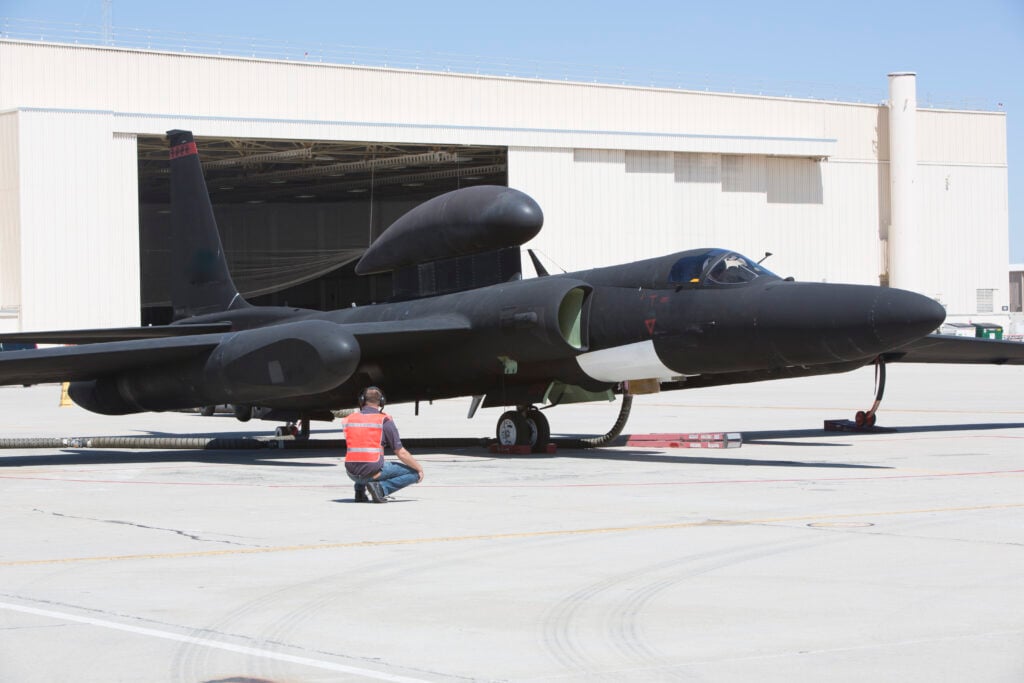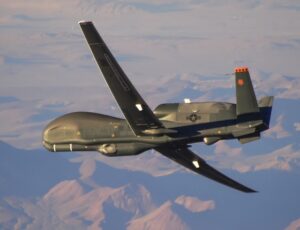U-2 Expert Says Global Hawk Just Can’t Compare
Posted on

U-2
Chris Pocock may know more about the U-2 than anyone who doesn’t possess a very high security clearance. He’s written four books about the planes and is passionate about the black beauties. Here’s his take on whether Northrop Grumman’s Global Hawk can rival or surpass the capabilities of the U-2. Read on. The Editor.
Northrop Grumman believes that it can “beef up” the sensor suite of the Global Hawk “to push its capabilities beyond those of the U-2.”
Really? How can this possibly happen, when this drone’s maximum altitude is at least 12,000 feet lower; it takes far longer to get there; its payload-by-weight is 50 percent less; its onboard recorder and comms/datalink capability for sensor transmission is inferior; and it has no electronic warfare capability? I could go on.
 The depressing thing about Northrop Grumman’s marketing of the Global Hawk has been the company’s evident determination to get the Dragon Lady withdrawn from service. Never mind that the US Air Force U-2 fleet has demonstrated a mission effectiveness rate of 97 percent, and has enough collective airframe life to last another 20 years. That is more airframe life than the Global Hawk, by the way.
The depressing thing about Northrop Grumman’s marketing of the Global Hawk has been the company’s evident determination to get the Dragon Lady withdrawn from service. Never mind that the US Air Force U-2 fleet has demonstrated a mission effectiveness rate of 97 percent, and has enough collective airframe life to last another 20 years. That is more airframe life than the Global Hawk, by the way.
The truth is, the US and its allies need the capabilities of both these high-altitude reconnaissance platforms. The Global Hawk offers superior endurance, and an alternative imaging system when carrying the MS-177 sensor made by UTA Aerospace Systems (UTAS). But UTAS also makes the SYERS-2C 10-band multispectral sensor carried by the U-2. The characteristics and status of the MS-177 version that has been flown on the Global Hawk, needs some clarification.

Global Hawk Block 40
Upgraded imaging systems like MS-177 and SYERS-2C offer the intelligence analyst superior detection of suspicious activity in a wider range of weather conditions. But ultimately, they cannot defeat cloud cover to the extent made possible by radar imaging systems. And here the U-2 offers a distinct advantage, with its Advanced Synthetic Aperture Radar System (ASARS). This has been providing all-weather, day/night coverage of trouble spots around the world for nearly 30 years. Made and supported by Raytheon, these sensors have been upgraded once already, and now a further upgrade with an active electronically-scanned array (AESA) is being developed for flight-test on a U-2 in prototype form.
This ASARS-2B version promises a doubling in range. That’s important for keeping an eye on countries like North Korea, where the U-2 can offer a deeper look from a safe and higher distance offshore. Incidentally, the U-2 can be quickly dispatched on such a mission from its deployed base at Osan in the south of the Korean peninsula. The Global Hawk must fly hours to reach the same area from its base on Guam. Why not also deploy the drone to Osan? Like many other countries, Korea won’t allow unmanned aircraft to fly in crowded, non-segregated airspace. Even if it did, the Global Hawk would face problems operating from wet and cold Osan – because it doesn’t have a de-icing system! (Editor’s note: Northrop is testing one now.)
The 11 Block 40 Global Hawks carry the new MP-RTIP radar sensor which offers superior moving target indication (MTI) compared with ASARS. But it is the 21 Block 30 versions that are supposed to replace the 26 operational U-2S models. In his latest report published in January, the Pentagon’s Director of Operational Test and Evaluation (DOT&E) reminded readers that he had “previously identified ground station, air vehicle, communication system, and cybersecurity shortfalls” in the Block 30 Global Hawk. He noted that a follow-on test and evaluation program was required, but not yet conducted.
The bottom line is, there is no other ISR asset flying today or in development, that can accomplish the daily peacetime operations of the U-2S or compete with its potential upgrades. The US Air Force has tried to retire the Dragon Lady several times in the past two decades. On every occasion, combatant commanders have told the Pentagon and Congress that they have an ongoing need for its unique capabilities.
It’s high time that the Air Force removed the threat of retirement, so that the Lockheed Martin SkunkWorks and the U-2 subcontractor team can fully develop the nascent potential that the Dragon Lady still offers. In addition to ASARS-2B, this includes a celestial navigation system to overcome the jamming of GPS signals (think North Korea again!); expanded spectrum SIGINT; extra bandwidth for transmission of sensor data; and a repositioning of the onboard payloads to permit single U-2 to become a ‘Tri-INT’ platform that can carry radar, optical and SIGINT sensors on the same mission.
Chris Pocock is the defense editor of Aviation International News and the author of four books on the history and current operations of the U-2.
Subscribe to our newsletter
Promotions, new products and sales. Directly to your inbox.
